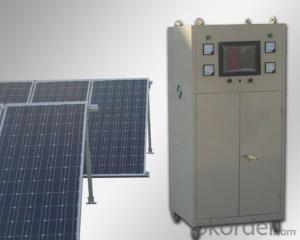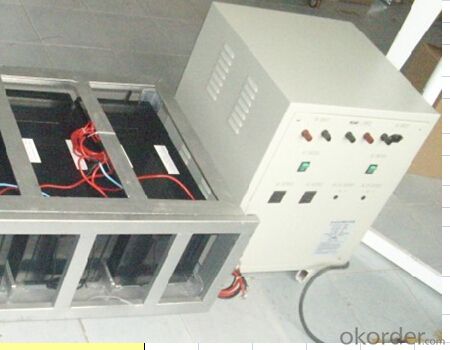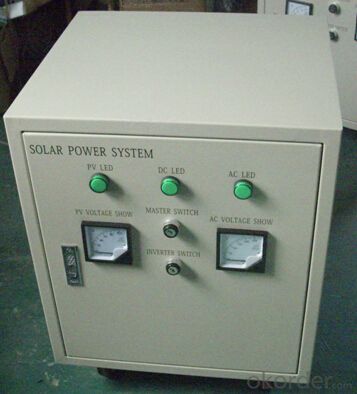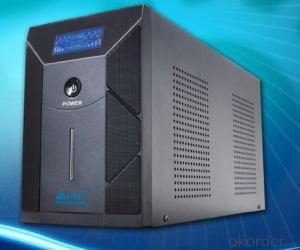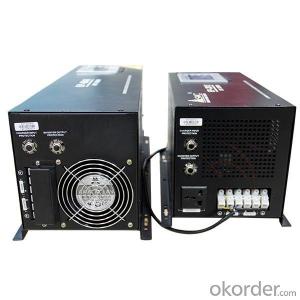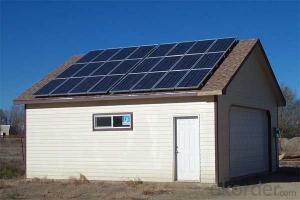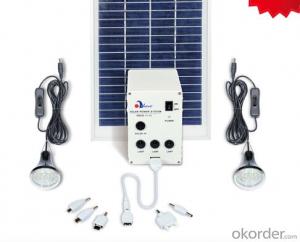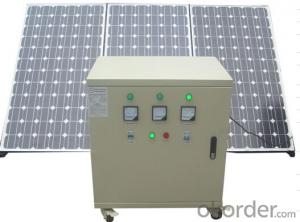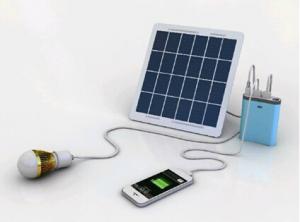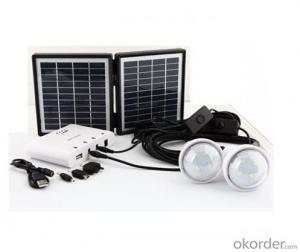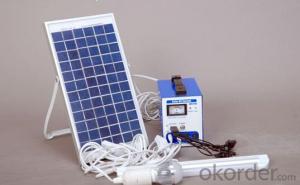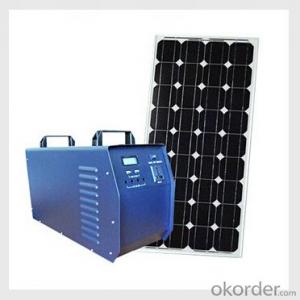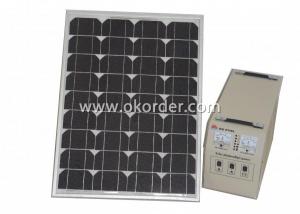Arc Solar Energy Systems CNBM 5000W Solar Home System Roof System Solar Energy
- Loading Port:
- Shanghai
- Payment Terms:
- TT or LC
- Min Order Qty:
- 1 pc
- Supply Capability:
- 30000 pc/month
OKorder Service Pledge
OKorder Financial Service
You Might Also Like
Working Principle of Solar Home System
The stand alone Solar Home System is an off-grid solar system which uses batteries to store the solar energy. Stand alone solar system solutions design for those who are not able or willing to connect to electricity grid.
However, our on-grid solar home system can be connected to the grid for utilization of grid electricity power. Our solar system can add relative equipment as our customer’s requirement which have the function of switching to city electricity automatically. The solar system can use battery power in priority, if sunshine is not so good or loads consumption is too high which cause battery power insufficient. Then system can switch automatically to grid power supply. Meanwhile, the system can charge the batteries with grid power until batteries are fully charged. Then the solar system will switch back to battery power supply.
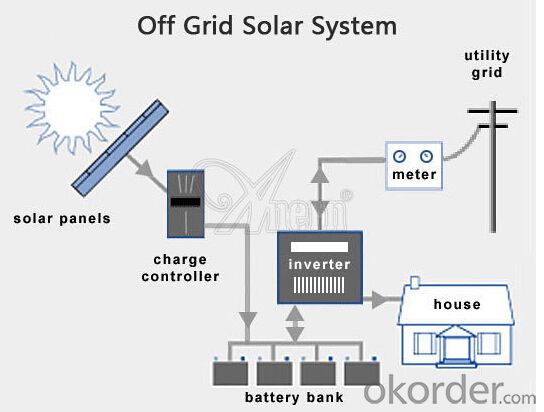
Product Details of Solar Home System
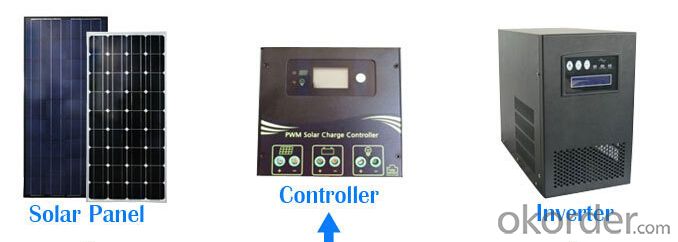
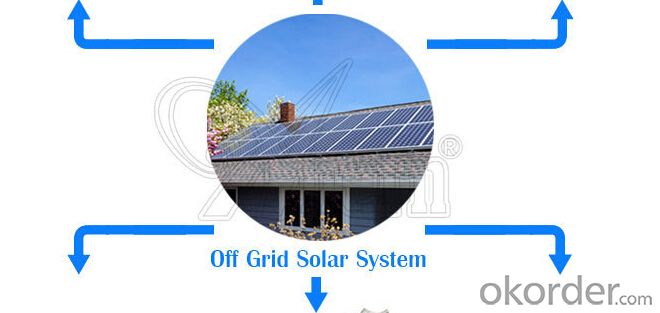

Specification of Solar Home System
Technical data: | ||||||||
Inverter | Rated load power | 5000W | ||||||
Output wave | Pure sine wave | |||||||
Input voltage | 110V | |||||||
Output voltage | DC:12V | |||||||
Output frequency | 50HZ/60HZ | |||||||
Precision of output frequency | ±6% | |||||||
Solar panel | Pmax | 180W*28PCS | ||||||
Vmp | 36V*4*7 | |||||||
Imp | 52.5A | |||||||
Charger controller | Charger voltage & current | 110V/60A | ||||||
Battery | Capacity | 12V/150AH*16PCS | ||||||
support | Aluminium | 4PCS/SET*7 | ||||||
Power box | Spray paint iron box,with input,output, ammeter,voltmeter,master switch and so on. | |||||||
Package data: | ||||||||
Part | Size (L*W*H mm) | Weight (kg) | 20' (pcs) | 40' (pcs) | ||||
Power box | 840*620*150 | 140 |
|
| ||||
Solar panel | 1610*830*100*(6ctns) | 180 | ||||||
Battery | 1100*520*650*2 | 1200 | ||||||
Loading electrical equipment(For consulting) | ||||||||
Name of Load | Power(W) | Quantity | Working Time per Day (H) | Working Days | ||||
Color TV | 65W | 2 | 6 | 3 days | ||||
Satellite TV Receivers | 25W | 2 | 6 | 3 days | ||||
lamp | 11W | 8 | 8 | 3 days | ||||
Computer | 150 W | 2 | 6 | 3 days | ||||
FAN | 60W | 4 | 6 | 3 days | ||||
Other | 3000W | 1 | 6 | 3 days | ||||
Advantage of Our Solar Home System
1 Excellent Performance: Our Solar Home System is composed by Brand Standard Kits with high quality. Our solar system has the advantage of high efficiency and stable operation. We can ensure our product with a long life period.
2. Small Orders Accepted: We can accept small orders as our customer’s trial order.
3. Warehouse: We have warehouse overseas which can bring great convenience to our customer to pick up the products.
- Q: What is the impact of electromagnetic interference on solar energy system performance?
- Electromagnetic interference can have a negative impact on the performance of solar energy systems. It can cause disruptions and fluctuations in the electrical signals and data transmission within the system, leading to reduced efficiency and reliability. Additionally, electromagnetic interference can interfere with the proper functioning of inverters and other critical components, potentially causing system failures and downtime. Therefore, it is crucial to implement proper shielding and mitigation measures to minimize the impact of electromagnetic interference on solar energy system performance.
- Q: How long does it take to recoup the investment in a solar energy system?
- The time it takes to recoup the investment in a solar energy system can vary depending on factors such as the cost of the system, the amount of energy it generates, the local electricity rates, available incentives, and the individual's energy consumption. On average, it typically takes around 5 to 10 years to recoup the initial investment in a residential solar energy system. However, with decreasing equipment costs and increasing government incentives, this payback period is continually reducing, making solar energy a more financially viable option for many individuals and businesses.
- Q: Can solar energy systems be financed?
- Yes, solar energy systems can be financed. There are several options available for financing solar energy systems, including loans, leases, and power purchase agreements (PPAs). One common financing option is a solar loan, which allows homeowners and businesses to borrow money to install a solar energy system and then repay the loan over time. These loans can be obtained from banks, credit unions, or solar financing companies. Solar loans may have fixed or variable interest rates and repayment terms ranging from 5 to 25 years. Another financing option is a solar lease, where the solar energy system is owned by a third-party and the homeowner or business pays a monthly lease payment to use the system. In this arrangement, the third-party is responsible for maintenance, repairs, and system performance. Solar leases often come with little to no upfront costs and can provide immediate savings on electricity bills. Power purchase agreements (PPAs) are another popular financing option for solar energy systems. With a PPA, a third-party developer installs and maintains the solar panels on a customer's property, and the customer agrees to purchase the electricity generated by the system at a predetermined rate. PPAs can provide a fixed rate for a specific period, allowing customers to lock in lower electricity costs and reduce their reliance on fossil fuels. In addition to these financing options, there are also various incentives and rebates available that can help reduce the cost of installing a solar energy system. These include federal tax credits, state and local incentives, and utility-based incentives. Overall, the availability of financing options for solar energy systems has made it more accessible for homeowners, businesses, and organizations to transition to clean and renewable energy sources.
- Q: Can a solar energy system be installed on a building with a thatched roof?
- Yes, a solar energy system can be installed on a building with a thatched roof. However, it may require additional considerations and adaptations to ensure the stability and durability of the system. Thatched roofs are typically made of natural materials like straw or reeds, which may not be as structurally strong or resistant to moisture as conventional roofing materials. Therefore, careful planning and consultation with solar energy experts are necessary to ensure proper installation techniques and the protection of the thatched roof.
- Q: Are there any limitations to the use of solar energy systems?
- Yes, there are some limitations to the use of solar energy systems. One major limitation is that solar panels require sunlight to generate electricity, so they are less effective in areas with limited sunlight or during cloudy periods. Additionally, solar energy systems are relatively expensive to install and maintain, which can deter some individuals or organizations from adopting this technology. Furthermore, the space required for solar panels may be a constraint, especially in densely populated areas. Finally, solar energy systems currently have lower energy conversion efficiency compared to traditional fossil fuel-based power plants, limiting their ability to fully replace conventional energy sources.
- Q: Can solar energy systems be installed on vehicles?
- Yes, solar energy systems can be installed on vehicles.
- Q: Can solar energy systems be used in powering movie theaters or entertainment venues?
- Certainly, movie theaters and entertainment venues can absolutely utilize solar energy systems to provide power. The operation of these venues requires a substantial amount of electricity for their lighting, sound systems, projectors, and other equipment. Solar energy systems have the ability to generate clean and renewable electricity by harnessing the sun's power. By installing solar panels on the roofs or in the surrounding areas of these venues, they can generate a significant amount of electricity to fulfill their energy requirements. Not only can solar energy systems be designed to supply power for the basic infrastructure of movie theaters or entertainment venues, but they can also support additional energy-intensive features such as HVAC systems, concession stands, and even electric vehicle charging stations. By utilizing solar energy, these venues can greatly reduce their dependence on grid electricity, decrease operational expenses, and contribute to a more sustainable and environmentally friendly future. Besides the practical advantages, the installation of solar energy systems in movie theaters or entertainment venues can also serve as a demonstration of environmental responsibility and attract environmentally conscious audiences. Many individuals are becoming increasingly aware of the significance of renewable energy, and by showcasing their commitment to sustainability, these venues can enhance their brand image and appeal to a wider customer base. In conclusion, the utilization of solar energy systems to power movie theaters or entertainment venues is not only technically viable but also financially and environmentally beneficial. By harnessing the sun's power, these venues can diminish their carbon footprint, save on energy costs, and contribute to a greener future for the entertainment industry.
- Q: How do solar energy systems affect the roof's lifespan?
- Solar energy systems can actually extend the lifespan of a roof. The panels provide an additional layer of protection to the roof, shielding it from harmful elements like UV rays and extreme weather conditions. Additionally, the panels help to regulate the temperature of the roof, reducing thermal stress and preventing premature aging.
- Q: What is the impact of roof color on the performance of solar panels?
- The impact of roof color on the performance of solar panels can be significant, although it primarily depends on the type of solar panel technology being used. In general, the color of the roof can affect the overall efficiency and output of solar panels due to its impact on the temperature and reflection of sunlight. Roof color plays a role in the absorption and reflection of solar radiation. Dark-colored roofs tend to absorb more sunlight, which can lead to increased heat buildup on the roof's surface. This excess heat can affect the performance of solar panels negatively, as they operate less efficiently at higher temperatures. The elevated temperature can cause a decrease in the overall power output of the panels, reducing their energy generation potential. On the other hand, light-colored roofs reflect more sunlight, which helps in preventing excessive heat build-up. By reflecting a significant portion of the solar radiation, the roof's color can help to keep the panels cooler and maintain their optimal operating temperature. This can result in better performance and higher energy production from the solar panels. However, it is important to note that the impact of roof color can vary depending on the type of solar panel technology used. Certain types of solar panels, such as monocrystalline or polycrystalline, may be more sensitive to temperature changes and thus more affected by roof color. In contrast, thin-film solar panels are generally less affected by temperature variations, making the impact of roof color less significant in their case. Additionally, other factors like the climate, local weather conditions, and the orientation and tilt of the solar panels can also influence their performance more than the roof color alone. Proper installation and maintenance of the solar panel system, including proper ventilation and shading, can further mitigate the impact of roof color on panel performance. In conclusion, while roof color can have an impact on the performance of solar panels, it is just one of many factors that can affect their efficiency and energy production. It is essential to consider the specific type of solar panel technology, local environmental conditions, and proper installation practices to maximize the performance of solar panels, regardless of the roof color.
- Q: Can solar energy systems be used in areas with limited roof space due to chimneys or vents?
- Yes, solar energy systems can still be used in areas with limited roof space due to chimneys or vents. While it is true that solar panels typically require a certain amount of unobstructed roof space for optimal efficiency, there are alternative solutions available for areas with limited roof space. One option is to install solar panels on flat or sloped surfaces adjacent to the roof, such as on the ground or on a nearby wall. These ground-mounted or wall-mounted solar systems can be adjusted to maximize exposure to sunlight, ensuring that the panels still generate a significant amount of energy. Another solution is to use solar technologies that are specifically designed for limited roof space. For example, there are solar tiles available that can be integrated into the roof itself, replacing traditional roofing materials while still harnessing solar energy. These solar tiles can be installed around chimneys, vents, or any other obstructions on the roof, making efficient use of the available space. Additionally, solar energy systems can also be combined with other renewable energy sources, such as wind turbines or geothermal systems, to compensate for the limited roof space. By diversifying the renewable energy sources, it is possible to meet the energy needs of an area even with limited roof space. In conclusion, while limited roof space due to chimneys or vents may pose some challenges, there are still viable options for utilizing solar energy systems. By exploring alternative mounting options, using solar tiles, or combining solar with other renewable energy sources, it is possible to harness solar power in areas with limited roof space.
Send your message to us
Arc Solar Energy Systems CNBM 5000W Solar Home System Roof System Solar Energy
- Loading Port:
- Shanghai
- Payment Terms:
- TT or LC
- Min Order Qty:
- 1 pc
- Supply Capability:
- 30000 pc/month
OKorder Service Pledge
OKorder Financial Service
Similar products
Hot products
Hot Searches
Related keywords
